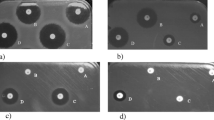Abstract
The VITEK 2 AST-N111 card was evaluated for detection of extended-spectrum beta-lactamases (ESBLs) by testing 51 ESBL positive and 50 ESBL negative isolates of E. coli, K. pneumoniae, and K. oxytoca. The occurrence of beta-lactamase genes was confirmed by PCR and sequencing. The advanced expert system (AES) of the VITEK 2 system achieved sensitivity and specificity values of 100% and 96.0%, respectively. The ESBL test of the VITEK 2 AST-N111 card showed a sensitivity of 92.1% and a specificity of 90.0%. Contradictory results obtained with the two VITEK 2 tools could be clarified by combination disk tests in nine of 11 isolates. The combined use of AES and ESBL tests of the AST-N111 card in association with combination disk tests in case of contradictory results seems to be a reliable method for ESBL detection.
Similar content being viewed by others
References
Canton R, Novais A, Valverde A et al (2008) Prevalence and spread of extended-spectrum beta-lactamase-producing Enterobacteriaceae in Europe. Clin Microbiol Infect 14(Suppl 1):144–153
Spanu T, Sanguinetti M, Tumbarello M et al (2006) Evaluation of the new VITEK 2 extended-spectrum beta-lactamase (ESBL) test for rapid detection of ESBL production in Enterobacteriaceae isolates. J Clin Microbiol 44:3257–3262
Wiegand I, Geiss HK, Mack D, Sturenburg E, Seifert H (2007) Detection of extended-spectrum beta-lactamases among Enterobacteriaceae by use of semiautomated microbiology systems and manual detection procedures. J Clin Microbiol 45:1167–1174
Thomson KS, Cornish NE, Hong SG, Hemrick K, Herdt C, Moland ES (2007) Comparison of Phoenix and VITEK 2 extended-spectrum-beta-lactamase detection tests for analysis of Escherichia coli and Klebsiella isolates with well-characterized beta-lactamases. J Clin Microbiol 45:2380–2384
Farber J, Moder KA, Layer F, Tammer I, Konig W, Konig B (2008) Extended-spectrum Beta-lactamase detection with different panels for automated susceptibility testing and with a chromogenic medium. J Clin Microbiol 46:3721–3727
Drieux L, Brossier F, Sougakoff W, Jarlier V (2008) Phenotypic detection of extended-spectrum beta-lactamase production in Enterobacteriaceae: review and bench guide. Clin Microbiol Infect 14(Suppl 1):90–103
Grobner S, Linke D, Schutz W et al (2009) Emergence of carbapenem-non-susceptible extended-spectrum beta-lactamase-producing Klebsiella pneumoniae isolates at the university hospital of Tubingen, Germany. J Med Microbiol 58:912–922
Cendejas E, Gomez-Gil R, Gomez-Sanchez P, Mingorance J (2010) Detection and characterization of Enterobacteriaceae producing metallo-beta-lactamases in a tertiary-care hospital in Spain. Clin Microbiol Infect 16:181–183
Woodford N, Fagan EJ, Ellington MJ (2006) Multiplex PCR for rapid detection of genes encoding CTX-M extended-spectrum (beta)-lactamases. J Antimicrob Chemother 57:154–155
Robin F, Delmas J, Schweitzer C, Bonnet R (2008) Evaluation of the Vitek-2 extended-spectrum beta-lactamase test against non-duplicate strains of Enterobacteriaceae producing a broad diversity of well-characterised beta-lactamases. Clin Microbiol Infect 14:148–154
Rice LB, Carias LL, Hujer AM et al (2000) High-level expression of chromosomally encoded SHV-1 beta-lactamase and an outer membrane protein change confer resistance to ceftazidime and piperacillin-tazobactam in a clinical isolate of Klebsiella pneumoniae. Antimicrob Agents Chemother 44:362–367
Potz NA, Colman M, Warner M, Reynolds R, Livermore DM (2004) False-positive extended-spectrum beta-lactamase tests for Klebsiella oxytoca strains hyperproducing K1 beta-lactamase. J Antimicrob Chemother 53:545–547
Gulmez D, Woodford N, Palepou MF et al (2008) Carbapenem-resistant Escherichia coli and Klebsiella pneumoniae isolates from Turkey with OXA-48-like carbapenemases and outer membrane protein loss. Int J Antimicrob Agents 31:523–526
Pournaras S, Poulou A, Voulgari E, Vrioni G, Kristo I, Tsakris A (2010) Detection of the new metallo-beta-lactamase VIM-19 along with KPC-2, CMY-2 and CTX-M-15 in Klebsiella pneumoniae. J Antimicrob Chemother 65:1604–1607
Acknowledgements
Neil Woodford and Jesus Mingorance are acknowledged for donation of the control strains. We are grateful to Gabi Heinze and Simone Pusch for expert technical assistance.
Author information
Authors and Affiliations
Corresponding author
Rights and permissions
About this article
Cite this article
Valenza, G., Müller, S., Schmitt, C. et al. Evaluation of the VITEK 2 AST-N111 card for detection of extended-spectrum beta-lactamases (ESBLs) in Escherichia coli, Klebsiella pneumoniae, and Klebsiella oxytoca compared to ESBL Etests and combination disk methods. Eur J Clin Microbiol Infect Dis 30, 869–872 (2011). https://doi.org/10.1007/s10096-011-1169-2
Received:
Accepted:
Published:
Issue Date:
DOI: https://doi.org/10.1007/s10096-011-1169-2




